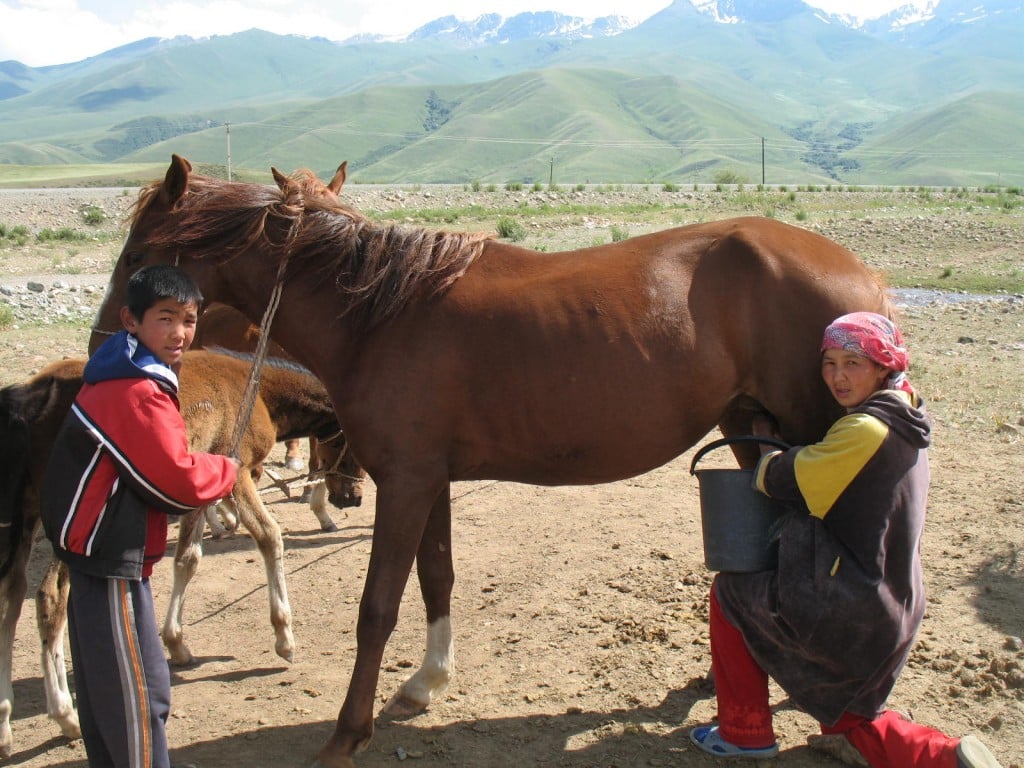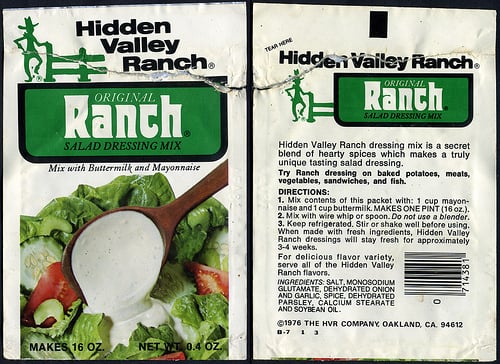De Condimentis (12): Sour Cream
By:
June 10, 2011
This is the twelfth installment in Tom Nealon’s acclaimed and apophenic food history series De Condimentis.
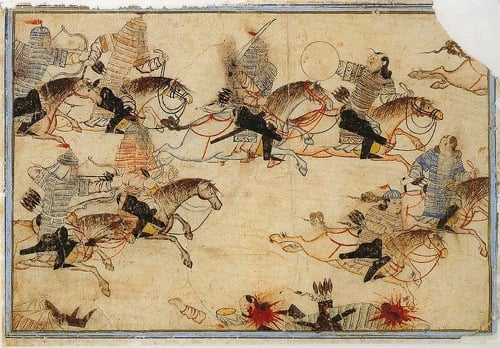
In 1238, Subutai, chief General to the Khan, successfully took over Volga Bulgaria and Russia in a series of swift, bloody, engagements. The Mongols built a capital city, Sarai, on a southern channel of the river Volga, where the commander of the Golden Horde collected tribute from the various princes of Russia for the next 240-some years. Eventually growing to an estimated population of 600,000, Sarai was a teeming metropolis and one of the greatest cities of the medieval world. The Mongols brought to the Russian frontier a gift for disciplined mayhem, the horse archer, and the fermented mare’s milk, kumis.
Kumis is mildly alcoholic and allows the frequently lactose-intolerant Mongolians to process their portable supply of milk. Lactic acid bacteria in the milk turn the lactose into lactic acid, making it digestible and imparting a pleasantly “sour” flavor; it then undergoes a brief alcoholic fermentation stage that gives it the alcohol content of watered-down beer (about one percent alcohol by volume, similar to medieval “small beer”). In the warmer climes, where it was difficult to keep milk from “turning,” it was better to control the souring process, marking for kumis a similar place in Mongolia as butter and cheese held in Europe, where culturing serves as a pleasant enhancer of shelf life. Lactic acid bacteria are responsible (though not always solely responsible) for turning milk into kefir, yogurt, and sour cream as well.
Until now, the precise source of the now-ubiquitous sour cream has always been elusive. While butter and cheese are ancient and mentioned frequently back to the beginnings of the written word, sour cream (smetana in Russian, Ukrainian, Swedish and Finnish, pavlaka in Bosnian, schmetten in German, tejföl in Hungarian, shtalpë in Albanian, grietinė in Lithuanian, and crème fraiche in French, amongst many others) has no such pedigree. Similar substances have been consumed in the East since antiquity (Pliny describes a Middle Eastern sour milk preparation he calls oxygala in the first century), but there is no evidence of its popularity in the west.
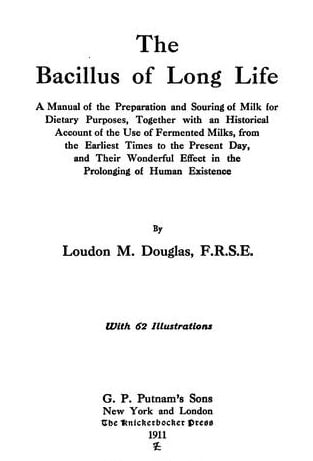
While this might seem a strange culinary oversight, consider the stranger fact that sour cream’s close cousin, yogurt, was basically unknown in western Europe until the nineteenth century, and not popular until after Loudon McQueen Douglas touted its life-lengthening properties in his 1911 The Bacillus of Long Life. Douglas claimed that in any village, scores of yogurt-enhanced southern-European centenarians went about their daily tasks, and people thought nothing of 110- and 120-year-olds performing jobs that in western Europe wouldn’t be entrusted to a 65-year-old. The whole array of warm-weather-fermented dairy products, so important now, took forever to catch on, dawdling their sour way into our diets.
What’s now clear is that at some point, this kumis-drinking horde sitting on their border inspired Russian dairy engineers to create a a non-alcoholic version, adapted to the Russian diet. There’s little difference in preparation; dairy undergoing lactic acid bacteria fermentation is, as they say, dairy undergoing lactic acid bacteria fermentation. The Russians just applied the process to cow’s milk and allowed the product to thicken further. The profusion of names for sour cream in many of the countries where it is most popular also suggests that it was discovered by all of them simultaneously — for example, each of the three Baltic states, Latvia, Estonia and Lithuania have a completely different name for sour cream (skābais krējums, hapukoor, and grietinė respectively). By the seventeenth century, sour cream was sufficiently entrenched in Russia that Peter the Great’s love of it was viewed as an appropriate and simple love of Mother Russia.
Moving inexorably westward, sour cream was likely brought by Yiddish-speaking immigrants into Germany and from there into France where it became crème fraiche and began appearing in cookery books in the early eighteenth century (including Liger’s Le menage de la ville et des champs and later editions of L’École parfaite des officiers de bouche first published in 1662). There’s long been a suggestion from the French culinary cabal, operating at near subliminal levels, that crème fraiche is something apart from the decadent condiment deployed by the vulgar, potato-eating, sour-cream-dolloping masses; it’s not. It does have a higher fat and lower protein content than American-style sour cream, making it possible to use it as an ingredient in dishes without it cooking or burning, but the same is true for most Eastern European and Russian (smetana) sour creams. Real sour creams, of which crème fraiche is a late example, are all an ingredient, condiment, and sauce rolled into one.
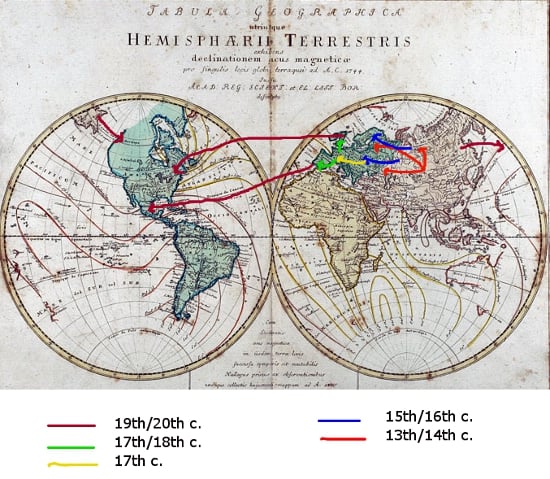
With a few additions (often scallions, onions, garlic, parsley, thyme, or dill), sour cream as it’s used in Russia serves as a topping for everything from borscht to potato, from fish to beef with dumplings. Sour cream, like yogurt, came to the New World late, and didn’t become popular outside of ethnic enclaves in large cities until the middle of the 20th century. When it did become popular, it was a more acidic version with a lower fat content not suitable for cooking, and mostly was used as a condiment. One thing that struck me about common versions of smetana is how similar they are to a popular American salad dressing…
Ranch is now the most popular salad dressing in the U.S., and has made a pair of sideways leaps into sauce/dip and flavoring as well. What could be more American? It’s called ranch, and it’s horrifically bad for you. When I lived in Albuquerque, NM, fifteen years ago, everyone dipped their pizza in it like that was a normal thing to do (aside: it’s not).
Bound up in western mystique and brand identity, the genesis story of ranch dressing (as found at the Hidden Valley Ranch website) is alluring:
Nestled in the mountains, he stumbled upon 120 acres of sprawling land filled with streams, waterfalls and picturesque views outside Santa Barabara, California. It was here that Hidden Valley Ranch was born.
The family bought the land in 1954 and ran Hidden Valley Ranch, offering hiking tours, horseback riding and fishing, in the day. At night, folks would enjoy a home-cooked meal before gathering around the campfire to listen to stories. Guests came to enjoy the great outdoors and wholesome meals, but it was something else that made them come back: the delicious, homemade buttermilk salad dressing with a special blend of herbs and spices lovingly prepared by the proprietor — what we know today as the original Ranch dressing.
Guests loved it, asking for jars to take home for family and friends to try. Soon there was so much demand for the dressing that a mail-order business began by shipping Hidden Valley Ranch dressing out to an ever-growing fan base.
It almost brings a tear to your eye, doesn’t it? In later interviews it comes out that Steven Henson invented the recipe while working as a plumbing contractor in Alaska starting in 1949. He needed to feed his crew, and needed something tasty to keep their spirits up. Now, maybe it’s all true. Why not right? Go west young man, dude ranches, fatty dressing, Alaska, sold the recipe to Clorox in 1972 for $8 million; it’s like a fairy tale. But it also has that funny ring to it that many food origin stories do, a curious combination of the convenient and the vague.
Now, I know what you’re thinking: Hidden Valley ranch is made with mayonnaise and buttermilk — what on earth does this have to do with sour cream? But here we reach the nub of the story.
On September 23, 1949, Harry Truman announced that the Russians had conducted a test of a nuclear bomb (the test itself was on August 29). In 1949, Alaska Airlines’ worldwide charter business, the world’s largest, was shut down by the Civil Aeronautics Board (CAB). The airline had previously run charter flights to everywhere, including participating in airlifts from Yemen to Israel (Operation Magic Carpet), Berlin, China and Russia. In August 1950 a grand jury was convened to examine evidence that the Rosenbergs, and others, passed nuclear secrets to the Soviet Union. And around 1950, Russia evacuated the native population of “Big Diomede Island” in the middle of the Bering Strait on the Russia/US border, and built a military base there. The U.S. responded with a more restrained base of their own on “Little Diomede”. The Diomedes are 2.4 miles apart.
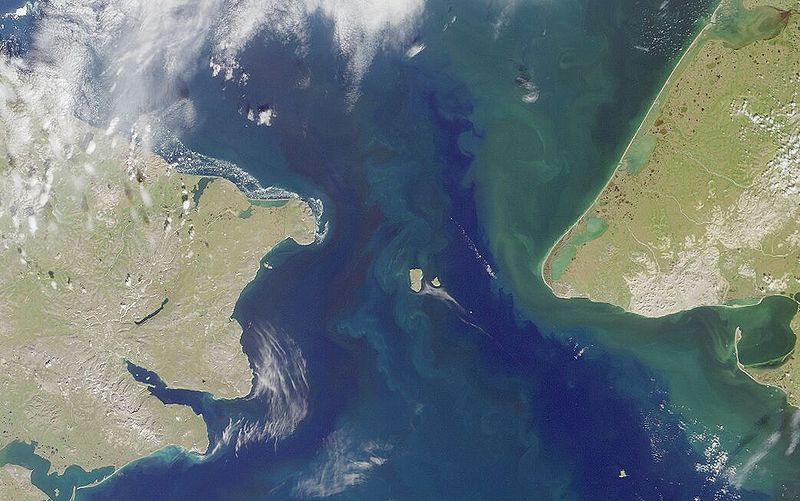
All of which is just to set the stage and point out that the Alaska that Hidden Valley Ranch inventor Steve Henson was doing “plumbing contracting” in wasn’t Sarah Palin’s Alaska; oil hadn’t even been discovered there yet. Did Steve Henson travel on one of these “charter flights” to Russia and discover (or trade for) the secret of smetana with fresh herbs? Did he run into some old-time Alaskans who shared with him one of the last remaining remnants of Russian occupation? Did he do some plumbing contracting on Little Dolemide? Did a babushka at a flophouse in Barrow serve him a plate of potatoes and snowy owl covered in sour cream and herbs that resulted in the epiphany that inspired ranch dressing? The Cold War was nowhere as cold as in Alaska, so we’ll probably never know for sure where the original recipe came from — but as always, though all of the actual evidence is gone, the cover-up remains.
Ranch dressing contains scallions, garlic, onion, herbs, mayonnaise (or salsa mahonesa, as we prefer) and buttermilk. Buttermilk gets its name from being the liquid left behind after cultured butter is made, but in the post-pasteurization world, it’s milk that has been seeded with lactic acid bacteria to create a certain acidic tartness (essentially cow-milk kumis stopped short of the alcoholic fermentation stage). You see, Henson knew that even if you weren’t worried that your dressing was filched from the “focus of evil in the modern world” (Reagan), American sour cream is a little too tart and a little too thick for a dressing. What worked great with smetana just wasn’t going to work with off the shelf sour cream in the U.S.
Now, credit where credit is due, Henson’s solution was a little bit brilliant: add two locally available products — mayonnaise and buttermilk — that serve both to approximate the original, and disguise the origins of your concoction. With mayo you have your creamy, fat-laden base, and buttermilk thins it and, crucially, adds the lactic acid that keeps the dressing from tasting insipid. Even when commercialized, the packets called for both mayo and buttermilk — though Clorox, knowing that buttermilk wasn’t sufficiently common in refrigerators, eventually developed a version that had the acidity built in (and later the shelf-stable variety that caused a hallucinating Homer Simpson to say to his harem “I grow weary of your sexually suggestive dancing, bring me my ranch-dressing hose!”).
Born of necessity on the Mongolian steppe, passed from Grand Duchy to Tsardom to Empire to Soviet Union, secreted across an icy expanse of Cold-War suspicion, and reborn on a dude ranch outside of Santa Barbara 700 years later — delicious all the while.
MORE CONDIMENTS: Series Introduction | Fish Sauce | Diagram of Condiments vs. Sauces, etc. | Hot Sauce | Vinegar | Drunken Vinegar | Balsamic Vinegar | Food History | Barbecue Sauce | Butter | Mustard | Sour Cream | Maple Syrup | Salad Dressing | Gravy
STUFFED SERIES: THE MAGAZINE OF TASTE | AUGURIES AND PIGNOSTICATIONS | THE CATSUP WAR | CAVEAT CONDIMENTOR | CURRIE CONDIMENTO | POTATO CHIPS AND DEMOCRACY | PIE SHAPES | WHEY AND WHEY NOT | PINK LEMONADE | EUREKA! MICROWAVES | CULINARY ILLUSIONS | AD SALSA PER ASPERA | THE WAR ON MOLE | ALMONDS: NO JOY | GARNISHED | REVUE DES MENUS | REVUE DES MENUS (DEUX) | WORCESTERSHIRE SAUCE | THE THICKENING | TRUMPED | CHILES EN MOVIMIENTO | THE GREAT EATER OF KENT | GETTING MEDIEVAL WITH CHEF WATSON | KETCHUP & DIJON | TRY THE SCROD | MOCK VENISON | THE ROMANCE OF BUTCHERY | I CAN HAZ YOUR TACOS | STUFFED TURKEY | BREAKING GINGERBREAD | WHO ATE WHO? | LAYING IT ON THICK | MAYO MIXTURES | MUSICAL TASTE | ELECTRIFIED BREADCRUMBS | DANCE DANCE REVOLUTION | THE ISLAND OF LOST CONDIMENTS | FLASH THE HASH | BRUNSWICK STEW: B.S. | FLASH THE HASH, pt. 2 | THE ARK OF THE CONDIMENT | SQUEEZED OUT | SOUP v. SANDWICH | UNNATURAL SELECTION | HI YO, COLLOIDAL SILVER | PROTEIN IN MOTION | GOOD RIDDANCE TO RESTAURANTS.

